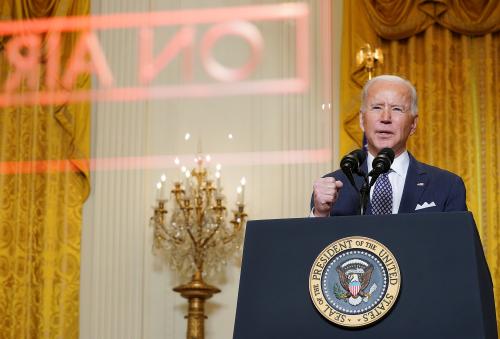One highlight of President Biden’s uneven first 12 months in office is the unprecedented demographic and career diversity—and the record numbers—of his district and court of appeals appointments (especially when contrasted to the slow pace of executive branch confirmations). First-year numbers, of course, are snapshots—the Trump administration’s modest first-year judicial confirmation number didn’t predict its four-year total, second only to Jimmy Carter’s.
That said, Biden’s 42 first-year appointees outnumber all but President Kennedy’s. Biden:
- submitted a substantial number of nominees early in the year;
- nominated heavily to courts with no opposition party senators; and
- saw his nominees receive unified Democratic support (and heavy Republican opposition) in Senate floor votes.
Later posts will discuss the impact of Biden’s first term appointments and prospects in 2022 (and beyond).
Biden’s first twelve months of appointments outpaced all predecessors in the four decades since the process has become more contentious. He had one more than President Reagan (although Reagan also got a Supreme Court appointment). Kennedy had 56, thanks in part to a big legislative infusion of new judgeships.

How Reagan and Biden reached their totals illustrates why presidents today may need party control of the Senate in order to seat many judges. Reagan submitted 43 first-year nominations; the Senate confirmed 40 of them—by unanimous consent motions, in about 30 days. Biden got two more confirmations. The speed of confirmations were 119 median days for district judges and 103 days for circuit judges. And he submitted almost one-and-a-half times as many nominees.
No confirmation was unanimous; indeed, 12 of his 19 district appointees and 12 of his 13 circuit appointees received 40 or more nay votes. Democratic unity was vital.
Almost all Reagan’s and H.W. Bush’s lower court appointees were approved by unanimous consent or voice vote. Over 90% of Clinton’s and Bush’s district judges were confirmed without opposition. That percentage went down almost 30 points with Obama, then sank like a rock under Trump. At the same time, strong opposition—measured by 40 or more “nay” votes—increased sharply after Obama. Opposition to circuit nominees was greater.

Had the filibuster been in place, requiring 60 votes to proceed on a judicial nomination, Biden’s (and to a lesser degree Trump’s) confirmation totals would be much lower.
The closest vote on a Biden nominee was 50-49 for a Ninth Circuit court of appeals nomination that deadlocked in the Judiciary Committee, fueled by what the nominee called her “overheated” criticism of then-Judge Brett Kavanaugh’s Supreme Court nomination. By comparison, another nominee breezed to confirmation as the first African American on the Court of Appeals for the Federal Circuit with only 34 nay votes.
Some opposition to Biden’s nominees was payback for Democratic senators’ opposition to Trump’s nominees. Other senators likely agreed with a colleague who voted against every Biden nominee because, as he said, “I just really don’t like them.”
Sen. Lindsey Graham (R-S.C.) expressed the old-fashioned view that “the president has the right to select judges . . . and as long as they are qualified, they should generally be confirmed.” Graham and GOP moderate Susan Collins (Maine), in addition to supporting less controversial nominees, voted for all 12 district appointees who received 40 or more nay votes; Collins and Murkowski also voted for seven of the 12 40-plus nay-vote circuit nominees (Graham voted for five).
Pace of nominations
Biden front loaded the process: 40% of his nominees came in the second quarter of his first year. Only George W. Bush came close to that level.

Both entered office with aggressive nomination agendas. Conservative legal groups presented Bush with like-minded candidates. Biden had chaired the Senate Judiciary Committee, is committed to diversity, and, perhaps, hopes to mollify progressives upset by his opposition to Supreme Court structural change. And neither faced first-year energy-sapping Supreme Court vacancies. Clinton’s first lower-court nominees came a few days after Justice Ginsburg’s August 3 confirmation. Trump submitted only a single nominee before Justice Gorsuch’s April 7 confirmation. Absent Supreme Court nominations, Reagan and Obama might have submitted more than the handful they did while the nominations were pending.
Nominations and Senate delegations
Fifty-eight (94%) of Biden’s 62 district nominations and 11 of his 13 circuit nominations were to courts with two Democratic senators or no senators (e.g., Puerto Rico). Presidents in their first year have increasingly concentrated nominees in that manner because Senate leadership has historically granted home state senators of either party at least a say—and sometimes a veto—over judicial nominations. During the Obama administration, Senate leadership processed no nominations that home state senators opposed. During the Trump administration, home state senators influenced district but not circuit nominations.
The nomination process slows to the degree White Houses bargain with home-state senators, seeking nominees whom those senators will not oppose once nominated. Generally White Houses have found smoother sailing with home-state senators of their own party. Table 4 shows the median days between vacancy date and nomination for all nominees, and then for vacancies on courts with no opposition-party senators. With four exceptions, nominations, overall came more quickly in those states. However, it is important to note that Republican home-state senators weren’t the only obstacle to speedy nominations. For example, a vacancy in the District of Columbia, announced in February 2021, waited 11 months for a nominee.

For whatever reason, there has been an increase, albeit uneven, in first-year nominations to courts with no opposition-party senators—rising from 33% for circuit vacancies in Reagan’s first year to 53% for Trump and 85% for Biden. There was a similar trend in first year nominations for district court vacancies rising from 26% in Reagan’s first year to 76% for Trump to Biden’s 94%.
Biden’s few split-delegation nominations were to a Pennsylvania seat on the Third Circuit’s court of appeals and four to districts in Ohio and Wisconsin. Biden’s one nomination to a two-Republican senator state (Tennessee) led one of its senators to complain that it was “incredibly disrespectful to the precedent that has been accorded to the other side.” Democrats replied that Republicans during the Trump presidency abandoned the deference to home-state senators.
To summarize, the Biden administration’s aggressive nomination effort and unified Senate Democrats achieved more first year judicial confirmations than any president since Kennedy in 1961. My next post in this series will consider the impact of these nominations on the judiciary.
Footnote
1. Data from Federal Judicial Center Biographical Data Base , Administrative Office of U.S. Courts judicial-vacancies and authorized judgeship data, Library of Congress presidential nominations, and data I have gathered and analyzed from these and other sources.






Commentary
Biden’s first-year judicial appointments—process
January 26, 2022